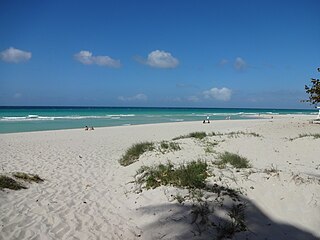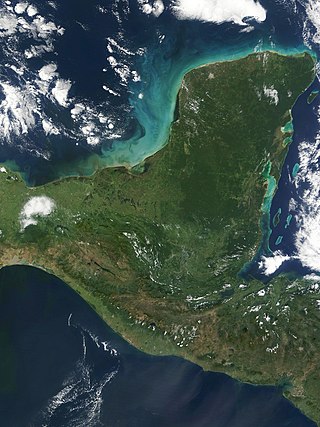
The Bay of Pigs is an inlet of the Gulf of Cazones, located on the southern coast of Cuba. By 1910 it was included in Santa Clara Province, and then to Las Villas Province by 1961, but in 1976, it was reassigned to Matanzas Province, when the original six provinces of Cuba were re-organized into 14 new Provinces of Cuba.

Varadero, also referred to as Playa Azul, is a resort town in the province of Matanzas, Cuba, and one of the largest resort areas in the Caribbean. Varadero Beach is rated one of the world's best beaches in TripAdvisor's Traveler's Choice Awards since 2019, ranking at number 9 as of January 2024. Common activities include fishing and excursions to Matanzas, Cárdenas, and the Península de Zapata.
Sheck Exley was an American cave diver. He is widely regarded as one of the pioneers of cave diving, and he wrote two major books on the subject: Basic Cave Diving: A Blueprint for Survival and Caverns Measureless to Man. On February 6, 1974, Exley became the first chairman of the Cave Diving Section of the American National Speleological Society. During his career, he established many of the basic safety procedures used in cave and overhead diving today. Exley was also a pioneer of extreme deep scuba diving.

A cenote is a natural pit, or sinkhole, resulting when a collapse of limestone bedrock exposes groundwater. The term originated on the Yucatán Peninsula of Mexico, where the ancient Maya commonly used cenotes for water supplies, and occasionally for sacrificial offerings. The name derives from a word used by the lowland Yucatec Maya—tsʼonoʼot—to refer to any location with accessible groundwater.

The Yucatán Peninsula is a large peninsula in southeast Mexico and adjacent portions of Belize and Guatemala. The peninsula extends towards the northeast, separating the Gulf of Mexico to the north and west of the peninsula from the Caribbean Sea to the east. The Yucatán Channel, between the northeastern corner of the peninsula and Cuba, connects the two bodies of water.

Melissani Cave or Melissani Lake, also Melisani is a cave and cenote located on the island of Kefalonia, northwest of Sami, about 5 km (3.1 mi) Southeast of Agia Effimia, Northeast of Argostoli and Northwest of Poros. This sinkhole, resulting when a collapse of limestone bedrock exposes groundwater in 1953 creating the cenote. The Ionian Sea lies to the east with the Strait of Ithaca. Forests surround the cave and the mountain slope is to the west. Near the cave is the entry to the cave with parking lots and is passed almost in the middle of the main road linking Sami and Agia Efimia especially to the northern part of the island. Some say the water is so clear the boats look like they are floating on air.

The Great Blue Hole is a large marine sinkhole off the coast of Belize. It lies near the center of Lighthouse Reef, a small atoll 70 km (43 mi) from the mainland and Belize City. The hole is circular in shape, 318 m (1,043 ft) across and 124 m (407 ft) deep. It has a surface area of 70,650 square metres (760,500 sq ft). It was formed during several phases of the Quaternary glaciation when sea levels were much lower. Analysis of stalactites found in the Great Blue Hole shows that formation took place 153,000, 66,000, 60,000, and 15,000 years ago. As the ocean began to rise again, the cave was flooded. The Great Blue Hole is a part of the larger Belize Barrier Reef Reserve System, a UNESCO World Heritage Site.

Juan Gualberto Gómez Airport, formerly known as Varadero Airport, is an international airport serving Varadero, Cuba, and the province of Matanzas. The airport is located 5 km from the village of Carbonera, closer to the city of Matanzas than to Varadero. The closest airport to Varadero is Kawama Airport. In 2009, the airport handled 1.28 million passengers, making it the second busiest airport in Cuba after José Martí International Airport in Havana.

Dos Ojos is part of a flooded cave system located north of Tulum, on the Caribbean coast of the Yucatán Peninsula, in the state of Quintana Roo, Mexico. The exploration of Dos Ojos began in 1987 and still continues. The surveyed extent of the cave system is 82 kilometers (51 mi) and there are 28 known sinkhole entrances, which are locally called cenotes. In January 2018, a connection was found between Sistema Dos Ojos and Sistema Sac Actun. The smaller Dos Ojos became a part of Sac Actun, making the Sistema Sac Actun the longest known underwater cave system in the world.
Sistema Nohoch Nah Chich, is located 16.5 kilometers (10.3 mi) south of Akumal in Tulum Municipality of Quintana Roo state, southeastern Mexico. It is part of the Sistema Sac Actun underwater cave systems.

Aldama is a municipality of the northeastern Mexican state of Tamaulipas. According to the census of 2010, the municipality had an area of 3,672 square kilometres (1,418 sq mi) and a population of 29,470, including the town of Aldama with a population of 13,661.
Carlos Coste is a Venezuelan professional free diver.

Zacatón is a thermal water-filled sinkhole belonging to the Zacatón system - a group of unusual karst features located in Aldama Municipality near the Sierra de Tamaulipas in the northeastern state of Tamaulipas, Mexico. At a total depth of 339 meters (1,112 ft), it is one of the deepest known water-filled sinkholes in the world.
Uamh an Claonaite is the longest cave in Scotland. It consists of a series of dry passages and a series of at least six sumps which have been dived over the years.
The Hicacos Peninsula is a peninsula on Cuba's northern shore, in the province of Matanzas. The resort town of Varadero is located on the peninsula. The name comes from a species of cactus.
Sistema Sac Actun is an underwater cave system situated along the Caribbean coast of the Yucatán Peninsula with passages to the north and west of the city of Tulum. Discovery of a connection to Sistema Dos Ojos in 2018 made it the longest known underwater cave system. As of January 2023, it is the second longest underwater cave system in the world, only surpassed by Sistema Ox Bel Ha.
Julio Roloff is a Cuban composer that has collaborated with the Laboratorio Nacional de Música Electroacústica (LNME) founded by composer Juan Blanco, where he created numerous electroacoustic pieces.
The Sierra de Tamaulipas is an isolated, semi-tropical mountain range in the Mexican state of Tamaulipas. Its highest point is 1,260 m (4,130 ft). There are no cities or towns in the Sierra and the small population is largely agricultural. The higher elevations of the Sierra have forests of oak and pine, contrasting with the semi-arid brush that dominates at lower altitudes. Several archaeological sites establish that the Sierra de Tamaulipas was the northern outpost of the agricultural Mesoamerican peoples of eastern Mexico.
Little Blue Lake is a water-filled sinkhole (“cenote”) in the Australian state of South Australia located in the state's south-east in the locality of Mount Schank about 20 kilometres (12 mi) south of the municipal seat of Mount Gambier. It is notable locally as a swimming hole and nationally as a cave diving site. It is managed by the District Council of Grant and has been developed as a recreational and tourism venue.

Cave diving is underwater diving in water-filled caves. The equipment used varies depending on the circumstances, and ranges from breath hold to surface supplied, but almost all cave diving is done using scuba equipment, often in specialised configurations with redundancies such as sidemount or backmounted twinset. Recreational cave diving is generally considered to be a type of technical diving due to the lack of a free surface during large parts of the dive, and often involves planned decompression stops. A distinction is made by recreational diver training agencies between cave diving and cavern diving, where cavern diving is deemed to be diving in those parts of a cave where the exit to open water can be seen by natural light. An arbitrary distance limit to the open water surface may also be specified. Despite the risks, water-filled caves attract scuba divers, cavers, and speleologists due to their often unexplored nature, and present divers with a technical diving challenge.











